-
ARTÍCULO ORIGINAL
Middle-Range theory of the nursing diagnosis of sedentary lifestyle in young adults
Revista Brasileira de Enfermagem. 2024;77(4):e20230516
06/09/2024
Resumo
ARTÍCULO ORIGINALMiddle-Range theory of the nursing diagnosis of sedentary lifestyle in young adults
Revista Brasileira de Enfermagem. 2024;77(4):e20230516
06/09/2024DOI 10.1590/0034-7167-2023-0516
Visualizações0Ver maisABSTRACT
Objective:
To construct a middle-range theory for the nursing diagnosis of Sedentary Lifestyle in young adults.
Methods:
A methodological study for the validation of a nursing diagnosis based on a Middle-Range Theory, carried out in six stages: definition of the approach; definition of theoretical-conceptual models; definition of main concepts; development of a pictorial scheme; construction of propositions; establishment of causal relationships and evidence for practice. The theory construction was operationalized through an integrative review and supported by Roy’s adaptation model.
Results:
Three essential attributes were identified; 10 antecedents; 7 clinical consequences; a pictogram, 9 propositions, and 11 causal relationships and evidence for practice.
Conclusion:
The middle-range theory for the nursing diagnosis of Sedentary Lifestyle in young adults was constructed, expanding the understanding of this phenomenon, to be applied in clinical practice by nurses.
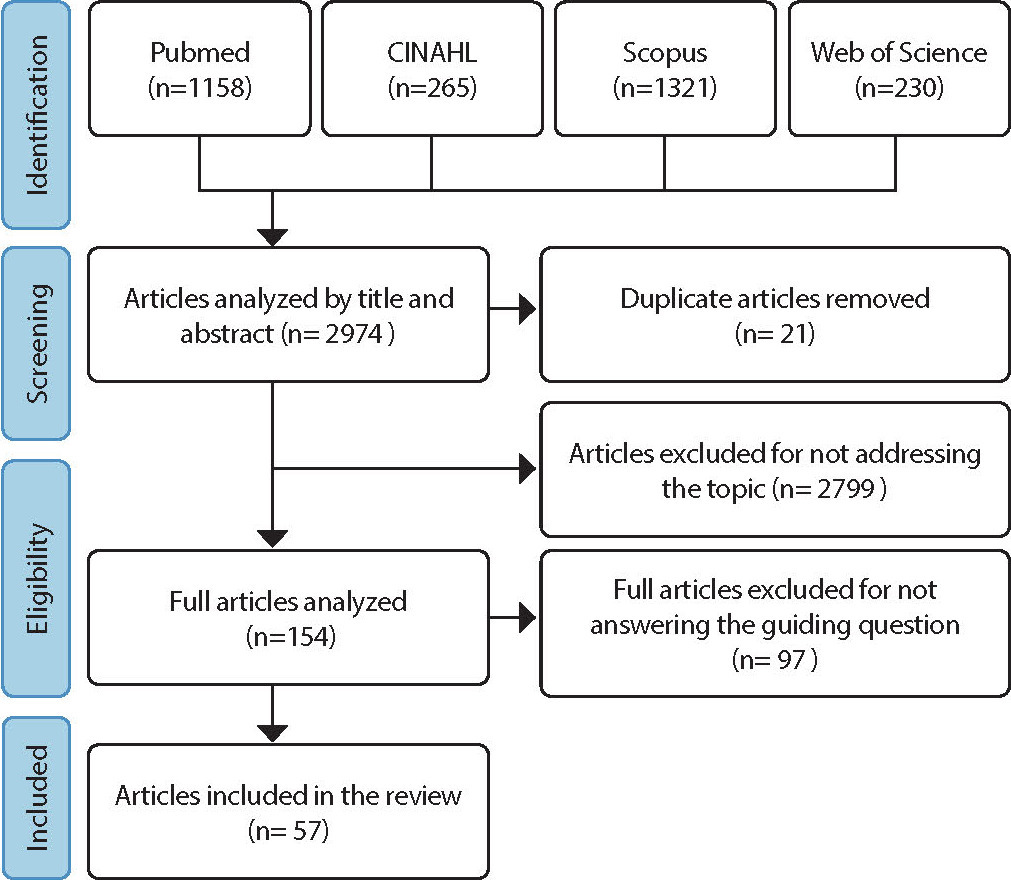
-
ARTÍCULO ORIGINAL
Physical and psychological changes of the COVID-19 infodemic by the older adult population
Revista Brasileira de Enfermagem. 2024;77(4):e20230339
06/09/2024
Resumo
ARTÍCULO ORIGINALPhysical and psychological changes of the COVID-19 infodemic by the older adult population
Revista Brasileira de Enfermagem. 2024;77(4):e20230339
06/09/2024DOI 10.1590/0034-7167-2023-0339
Visualizações0Ver maisABSTRACT
Objective:
to analyze the physical and psychological changes of the COVID-19 infodemic for the older adult population of Rio de Janeiro.
Method:
a cross-sectional, web-based survey to find out about access to news and information about COVID-19 among older adult in Rio de Janeiro, between July and December 2020. Univariate analysis and bivariate analysis were carried out using non-parametric statistical methods.
Results:
390 older adults took part, predominantly female (75.1%), aged between 66 and 75 (35.4%), married (51.0%), white (60.3%), owning their own home (81.8%), located in urban areas (91%), with complete or incomplete primary education (31.8%) and retired or pensioners (79.2%). Younger people were significantly affected both physically and psychologically by social networks when compared to television (<0.001).
Conclusion:
Physical and psychological changes from exposure to information about COVID-19 have affected the lives of the older adult, having an impact on this population.
-
Progress Test in nursing: perspectives for undergraduate education
Revista Brasileira de Enfermagem. 2024;77(4):e20230413
06/09/2024
Resumo
Progress Test in nursing: perspectives for undergraduate education
Revista Brasileira de Enfermagem. 2024;77(4):e20230413
06/09/2024DOI 10.1590/0034-7167-2023-0413
Visualizações0ABSTRACT
Objective:
to reflect on the perspectives of adopting the Progress Test in undergraduate nursing education.
Methods:
this is a reflective study, based on authors’ critical thinking and supported by national and international literature on the Progress Test application in undergraduate health courses.
Results:
the Progress Test is as a valuable teaching-learning strategy, with potential applications and benefits for students, professors, and academic management.
Final considerations:
systematic nursing education assessment indicates valuable information for different stakeholders. Understanding its potential benefits, the Progress Test is presented as a strategy that can be replicated in undergraduate nursing education, either individually, by institutions, or collaboratively, by the establishment of partnerships or consortiums of institutions.
Palavras-chave: Academic PerformanceEducation, NursingEducational MeasurementNursing Faculty PracticeSchoolsVer mais -
ARTÍCULO ORIGINAL
Effect of Brazilian green propolis in chronic ulcer treatment: a randomized clinical trial
Revista Brasileira de Enfermagem. 2024;77(4):e20230418
06/09/2024
Resumo
ARTÍCULO ORIGINALEffect of Brazilian green propolis in chronic ulcer treatment: a randomized clinical trial
Revista Brasileira de Enfermagem. 2024;77(4):e20230418
06/09/2024DOI 10.1590/0034-7167-2023-0418
Visualizações0Ver maisABSTRACT
Objective:
to assess the effectiveness of 5% Brazilian green propolis (ointment) in individuals with chronic ulcers.
Methods:
a randomized clinical trial, developed with 40 patients randomized equally to control group (treated with essential fatty acid) and experimental group (treated with 5% green propolis) for 30 days. The outcomes of interest were sociodemographic, clinical and laboratory characteristics, lesion characteristics, such as type of tissue in the bed, presence of exudate, edge characteristics, microbial content and pain.
Results:
regarding sociodemographic, clinical and laboratory characteristics, the two groups did not show statistically significant differences. After assessment in 30 days, an effect was observed for both treated groups, but for the experimental group, greater effectiveness in terms of the type of tissue in the bed, type of exudate, edge characteristics, microbial content and pain.
Conclusion:
propolis-based ointment showed a healing effect, presenting itself as a potential tool in healing chronic ulcers.
-
ARTÍCULO ORIGINAL
Adherence to sepsis protocol in a high-risk maternity reference center
Revista Brasileira de Enfermagem. 2024;77(4):e20230453
06/09/2024
Resumo
ARTÍCULO ORIGINALAdherence to sepsis protocol in a high-risk maternity reference center
Revista Brasileira de Enfermagem. 2024;77(4):e20230453
06/09/2024DOI 10.1590/0034-7167-2023-0453
Visualizações0Ver maisABSTRACT
Objective:
To describe the adherence to the sepsis protocol by obstetric nurses in the obstetric triage of a high-risk maternity reference center.
Methods:
This was a quantitative, documental, and retrospective study involving 105 pregnant women treated in obstetric triage under sepsis criteria. Data were collected through electronic medical records using structured forms and were organized into tables employing descriptive statistics. This research adhered to ethical principles concerning human studies.
Results:
Of the checklists for initiating the SEPSIS protocol by obstetric nurses, 105 were identified. Regarding the protocol steps performed, lactate was collected in 97.1% of cases and blood cultures in 98.1%, antibiotic therapy was administered in 94.3%, and hydration was carried out in 51.4% of the cases.
Conclusion:
The initiation of the sepsis protocol for all women meeting the criteria was confirmed. However, the steps were not fully implemented as recommended by the institutional protocol, and the recommended broad-spectrum antibiotic was not administered.
-
ARTÍCULO ORIGINAL
Factors associated with burnout in military police officers in a city in Paraná
Revista Brasileira de Enfermagem. 2024;77(4):e20230510
06/09/2024
Resumo
ARTÍCULO ORIGINALFactors associated with burnout in military police officers in a city in Paraná
Revista Brasileira de Enfermagem. 2024;77(4):e20230510
06/09/2024DOI 10.1590/0034-7167-2023-0510
Visualizações0Ver maisABSTRACT
Objective:
to analyze the association between burnout and sociodemographic, work factors, lifestyle habits and health conditions of military police officers in a municipality in the state of Paraná, Brazil.
Method:
cross-sectional research with 131 military police officers. Data were analyzed using the Statistical Package for the Social Sciences software and the R program. Chi-square, Fisher’s exact and Poisson Generalized Linear Model tests were used.
Results:
most participants (65.6%) had a high level of burnout. In relation to protective factors, those who carried out leisure activities had a 33.6% chance of not developing burnout. Conjugality was also a protective factor. Not practicing physical activity and leisure activities are factors that can contribute to the occurrence of burnout.
Conclusions:
important factors and high rates of burnout were observed in the police officers investigated. It is necessary to implement public health policies to reduce burnout with attention focused on this professional category.
-
ARTÍCULO ORIGINAL
Development and content validation of a risk classification instrument
Revista Brasileira de Enfermagem. 2024;77(4):e20230502
06/09/2024
Resumo
ARTÍCULO ORIGINALDevelopment and content validation of a risk classification instrument
Revista Brasileira de Enfermagem. 2024;77(4):e20230502
06/09/2024DOI 10.1590/0034-7167-2023-0502
Visualizações0Ver maisABSTRACT
Objective:
Develop and validate the content of an instrument for patient risk classification in emergency services of Primary Health Care.
Method:
The study included two stages: item generation and content validity. A literature review and retrospective analysis of medical records were conducted to create the instrument items. The Content Validity Ratio (CVR) was used to assess agreement among judges during content validation.
Results:
In the first and second rounds, 75 and 71 judges validated the risk classification instrument, respectively. The minimum adherence score for the latent variable item based on the final number of judges was 0.22 and 0.18; thus, 52 items, divided into three classification categories (red, orange, and yellow), were retained.
Conclusion:
The instrument was considered valid regarding clarity, relevance, pertinence, and agreement regarding the severity indicated in the item.
-
ARTÍCULO ORIGINAL
Nursing Process implementation in a gerontogeriatric context: qualitative research
Revista Brasileira de Enfermagem. 2024;77(4):e20230465
06/09/2024
Resumo
ARTÍCULO ORIGINALNursing Process implementation in a gerontogeriatric context: qualitative research
Revista Brasileira de Enfermagem. 2024;77(4):e20230465
06/09/2024DOI 10.1590/0034-7167-2023-0465
Visualizações0Ver maisABSTRACT
Objective:
to describe Nursing Process implementation in a faith-based senior living community.
Method:
strategic action research with 19 nursing professionals and three managers of a faith-based senior living community. Implementation took place in four phases: diagnosis, planning, implementation and assessment. The data collected through semi-structured interviews and focus groups were subjected to discursive textual analysis.
Results:
the central categories were constructed: Nursing Process in faith-based senior living community: diagnosis of knowledge and application; Nursing Process in faith-based senior living community: implementation; Nursing process in faith-based senior living community: assessment after its implementation.
Conclusion:
Nursing Process implementation made it possible to structure work management/organization, contributing to knowledge, organization and continuity of care for safety and professional support.
-
ARTÍCULO ORIGINAL
Fatores associados ao bem-estar materno em situação de parto de puérperas em Minas Gerais
Revista Brasileira de Enfermagem. 2024;77(6):e20230304
16/12/2024
Resumo
ARTÍCULO ORIGINALFatores associados ao bem-estar materno em situação de parto de puérperas em Minas Gerais
Revista Brasileira de Enfermagem. 2024;77(6):e20230304
16/12/2024DOI 10.1590/0034-7167-2023-0304pt
Visualizações1RESUMO
Objetivos:
analisar os fatores associados ao bem-estar materno em situação de parto de puérperas em Minas Gerais.
Métodos:
estudo transversal, aninhado a uma coorte, realizado com puérperas em um município mineiro. Foi adotada a escala Bem-Estar Materno em Situação de Parto 2. Estimaram-se as prevalências do bem-estar materno em situação de parto. A magnitude da associação entre mal-estar materno e práticas assistenciais foi estimada pela Razão de Prevalência (RP), utilizando-se a regressão de Poisson.
Resultados:
participaram 183 puérperas com idade entre 15 e 46 anos, sendo que 26,2%, 27,9% e 45,9% relataram, respectivamente, ótimo, adequado e mal-estar na assistência ao parto. O mal-estar materno foi mais prevalente entre puérperas que passaram por parto cesárea (RP = 1,60) e que não receberam informações sobre amamentação (RP = 1,59).
Conclusões:
observou-se elevada prevalência de mal-estar no parto, associada à realização de cesáreas e à falta de informações sobre amamentação.
Palavras-chave: Assistência ao PartoBem-Estar MaternoHumanização da AssistênciaParto ObstétricoPeríodo Pós-PartoVer mais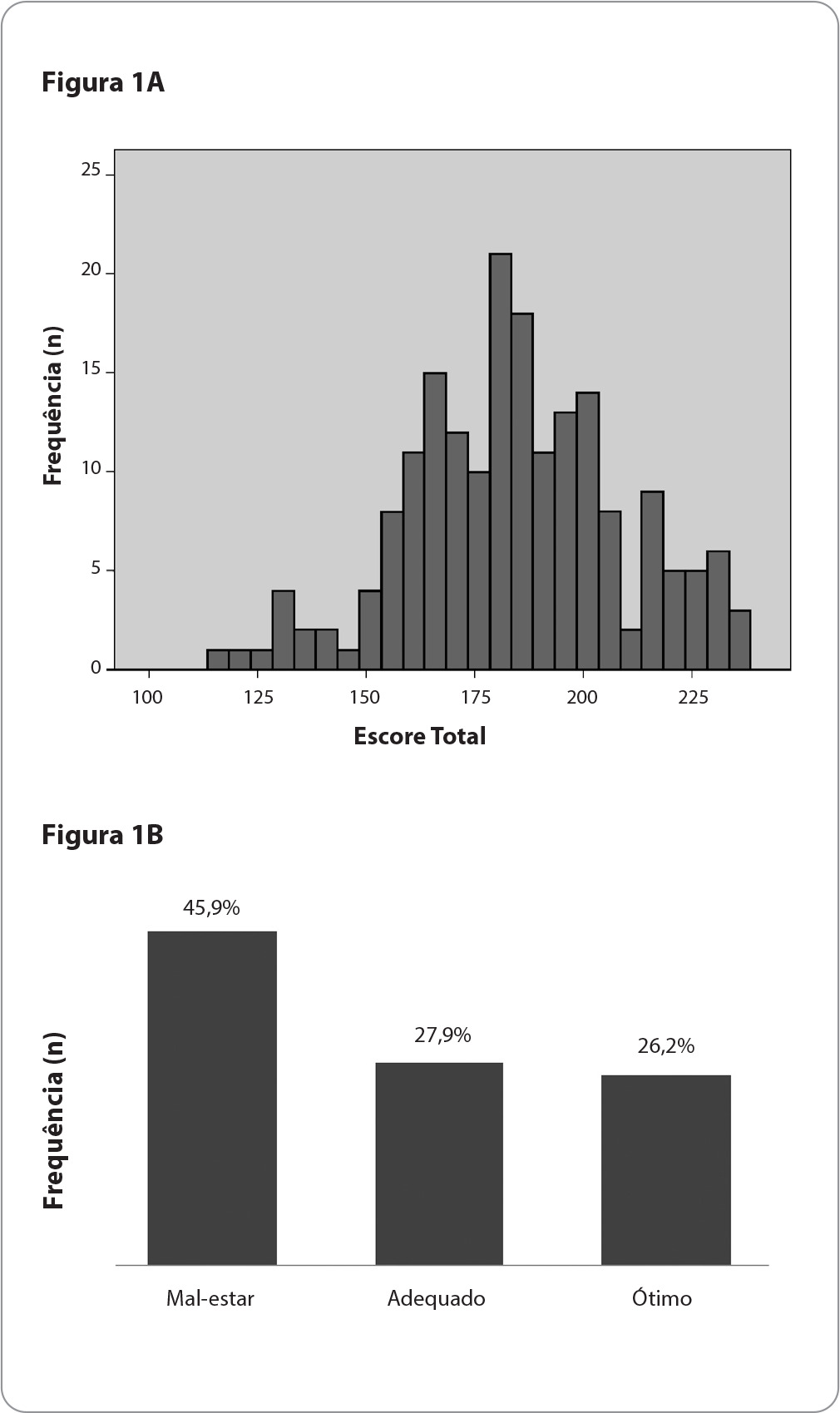
-
ARTÍCULO ORIGINAL
The nursing practice environment and hospital sociotechnical complexity: a mixed-methods study
Revista Brasileira de Enfermagem. 2024;77(6):e20230315
16/12/2024
Resumo
ARTÍCULO ORIGINALThe nursing practice environment and hospital sociotechnical complexity: a mixed-methods study
Revista Brasileira de Enfermagem. 2024;77(6):e20230315
16/12/2024DOI 10.1590/0034-7167-2023-0315
Visualizações1ABSTRACT
Objectives:
to analyze the relationship between the nursing practice environment and hospital sociotechnical complexity as perceived by nurses.
Methods:
a sequential explanatory mixed-methods study was conducted in a hospital in southern Brazil. The Brazilian version of the Practice Environment Scale-Nursing Work Index and the Complexity Characterization Questionnaire were administered to 132 nurses. Subsequently, semi-structured interviews were conducted with 18 participants, and the data were subjected to thematic analysis. Data integration was achieved through a connection approach.
Results:
the nursing practice environment was found to be favorable, except in the subscale concerning Staffing and Resource Adequacy, where complexity was present in the activities. The three emerging categories explained human and technical aspects related to complexity in the practice environment, quality of care, and patient safety. Unexpected variability was inversely correlated with the practice environment.
Conclusions:
the study results indicate a relationship between these constructs, with implications for the quality and the safety of care.
Palavras-chave: Complexity AnalysisHealth Facility EnvironmentNursingPatient SafetyQuality of Health CareVer mais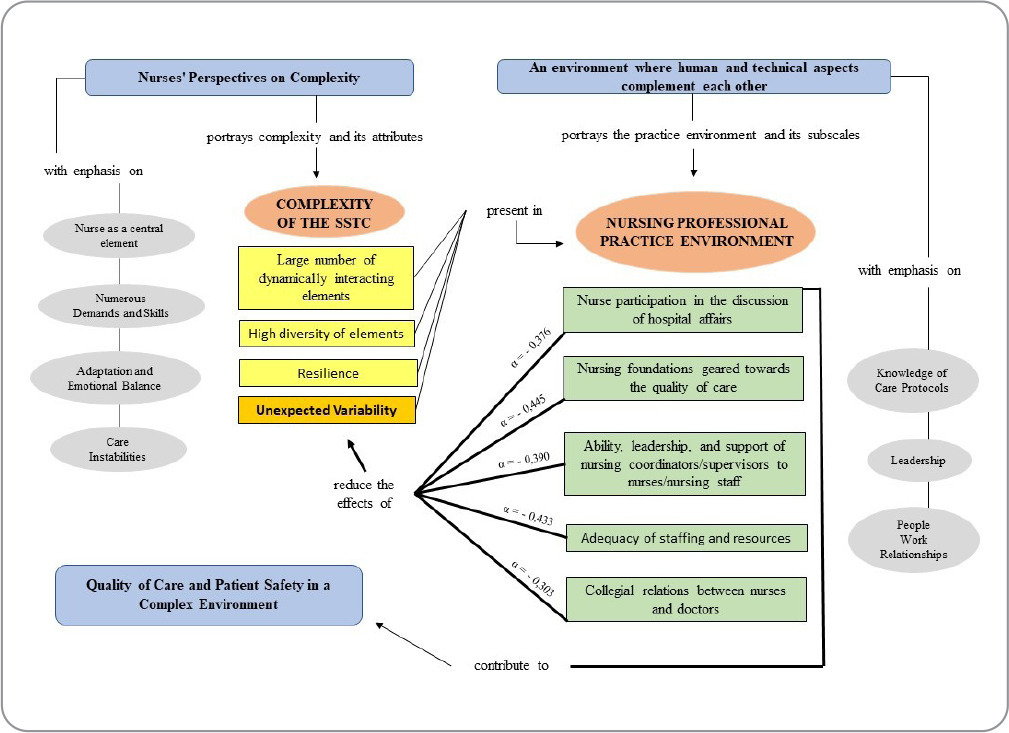
-
ARTÍCULO DE REVISIÓN
Recommendations for guidelines for promoting mental health in the workplace: an umbrella review
Revista Brasileira de Enfermagem. 2024;77(6):e20240086
16/12/2024
Resumo
ARTÍCULO DE REVISIÓNRecommendations for guidelines for promoting mental health in the workplace: an umbrella review
Revista Brasileira de Enfermagem. 2024;77(6):e20240086
16/12/2024DOI 10.1590/0034-7167-2024-0086
Visualizações1Ver maisABSTRACT
Objectives:
to summarize the recommendations of guidelines for promoting mental health in the workplace.
Methods:
an umbrella review, according to Joanna Briggs Institute and Preferred Reporting Items for Systematic reviews and Meta-Analyses methodological assumptions. Data collection was carried out in January 2021 and updated in July 2023 in the American Psychological Association, Cochrane Library, EMBASE, National Library of Medicine, and Scopus databases. Systematic reviews that assessed guidelines with recommendations for mental health care for workers were included. PROSPERO registration CRD42023461845.
Results:
four systematic reviews published between 2015 and 2018 were identified. The abstracts highlighted actions that facilitate and inhibit the recommendations as well as three categories of intervention: primary prevention – worker protection; secondary prevention – promoting workers’ mental health; and tertiary prevention – supporting, monitoring and rehabilitating workers upon returning to work.
Conclusions:
the interventions are based on prevention, promotion and early recognition, support and rehabilitation of mental health problems.
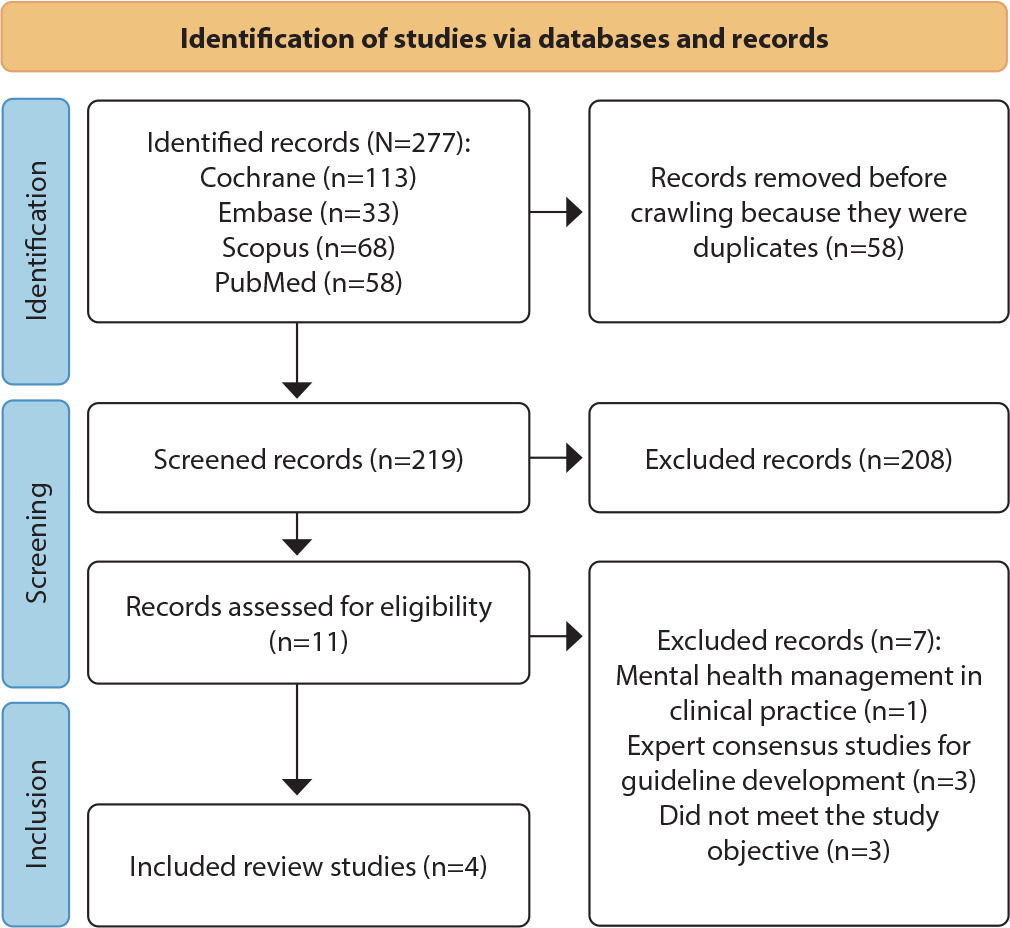
-
ARTÍCULO ORIGINAL
Avaliação do desempenho do escore de alerta precoce modificado em hospital público brasileiro
Revista Brasileira de Enfermagem. 2019;72(6):1428-1434
21/10/2019
Resumo
ARTÍCULO ORIGINALAvaliação do desempenho do escore de alerta precoce modificado em hospital público brasileiro
Revista Brasileira de Enfermagem. 2019;72(6):1428-1434
21/10/2019DOI 10.1590/0034-7167-2017-0537
Visualizações0RESUMO
Objetivo:
Avaliar o desempenho do escore de alerta precoce modificado (Mews) em uma enfermaria de pacientes em deterioração clínica.
Método:
Trata-se de um estudo analítico, quantitativo e preditivo. Os parâmetros do Mews (pressão arterial sistólica, frequência cardíaca, frequência respiratória, temperatura e nível de consciência) foram avaliados de 6 em 6 horas. Os seguintes eventos foram registrados: óbito, parada cardiorrespiratória e transferência para terapia intensiva. As avaliações foram realizadas em um hospital de referência do interior do estado de São Paulo.
Resultados:
Foram incluídos 300 pacientes (57 ± 18 anos, sexo masculino: 65%). Observou-se número crescente de eventos combinados de acordo com o maior valor do escore (00%; 00%; 01%; 09%; 19%; 28%; 89%, respectivamente, para os Mews 0; 1; 2; 3; 4; 5 e 6; p < 0,0001). Mews ≥ 4 foi o ponto de corte mais adequado para predição destes eventos (sensibilidade: 87%, especificidade: 85% e acurácia: 0,86).
Conclusão:
Mews mensura adequadamente a ocorrência de eventos graves em pacientes hospitalizados em enfermaria de um hospital público brasileiro. Mews ≥ 4 parece ser o ponto de corte mais adequado para predição destes eventos.
Palavras-chave: Cuidados CríticosCuidados de EnfermagemEquipes de Resposta Rápida de HospitaisEscores de Disfunção OrgânicaMedicina de EmergênciaVer mais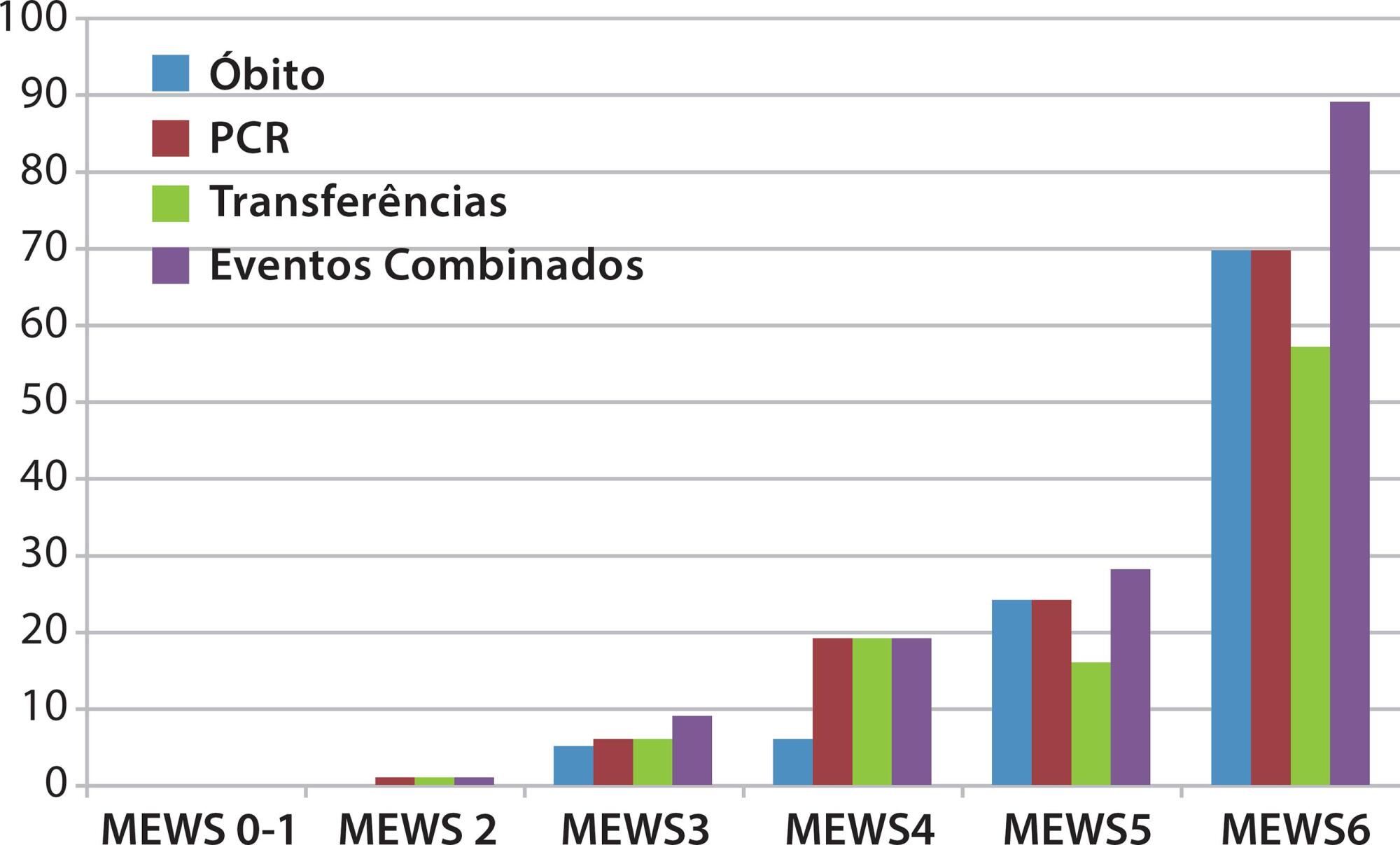
-
ARTÍCULO ORIGINAL
Biossegurança dos profissionais de enfermagem no enfrentamento da COVID-19
Revista Brasileira de Enfermagem. 2022;75:e20201104
18/10/2022
Resumo
ARTÍCULO ORIGINALBiossegurança dos profissionais de enfermagem no enfrentamento da COVID-19
Revista Brasileira de Enfermagem. 2022;75:e20201104
18/10/2022DOI 10.1590/0034-7167-2020-1104
Visualizações0RESUMO
Objetivo:
investigar a biossegurança dos profissionais de enfermagem no enfrentamento da COVID-19.
Métodos:
trata-se de estudo do tipo Survey. Os profissionais de enfermagem foram convidados via aplicativo de mensagens, utilizando formulários de coleta de dados autoaplicáveis. A seleção amostral (n=693) foi do tipo não probabilística. Realizou-se a análise descritiva dos dados.
Resultados:
considerando os aspectos da biossegurança no enfrentamento da COVID-19, 79,0% dos pesquisados não receberam treinamentos ou consideraram-nos insuficientes, 69,3% relataram a falta de equipamento de proteção individual nos serviços e 81,8% não se sentiram seguros com as adequações dos fluxos internos para o atendimento de casos da COVID-19.
Conclusão:
observam-se a necessidade de treinamento contínuo e efetivo da equipe de enfermagem e a disponibilidade de equipamentos de proteção individual, além da necessidade de adequações dos fluxos internos para o atendimento de casos suspeitos ou confirmados da doença.
Palavras-chave: BiossegurançaContenção de Riscos BiológicosEnfermagemEnfrentamentoInfecções por CoronavirusVer mais -
ARTÍCULO DE REVISIÓN
O uso de histórias infantis no cuidado de enfermagem à criança: revisão integrativa
Revista Brasileira de Enfermagem. 2019;72:333-342
13/12/2019
Resumo
ARTÍCULO DE REVISIÓNO uso de histórias infantis no cuidado de enfermagem à criança: revisão integrativa
Revista Brasileira de Enfermagem. 2019;72:333-342
13/12/2019DOI 10.1590/0034-7167-2018-0456
Visualizações0Ver maisRESUMO
Objetivo:
Identificar como as histórias infantis podem ser utilizadas no cuidado à criança.
Método:
Revisão integrativa da literatura, realizada em bases de dados, entre 2000 e 2018, em três idiomas. Foram incluídos artigos de pesquisa disponíveis na íntegra e que estavam de acordo com a seguinte questão: “Como as histórias infantis podem ser utilizadas no cuidado à criança?”.
Resultados:
A partir da análise de 16 artigos selecionados, emergiram três categorias: O uso de histórias no hospital; Intervenção de enfermagem especializada; e Histórias na dimensão educativa.
Considerações finais:
As evidências apontam benefícios às crianças, às famílias, às instituições e à Enfermagem. O uso de histórias infantis como intervenção de cuidado pode ocorrer em diferentes situações e cenários, valoriza e estimula vínculos, reduz ansiedade das crianças e familiares, estimula a participação das crianças no cuidado, e promove educação em saúde. É uma estratégia de baixo custo e ainda incipiente na Enfermagem.
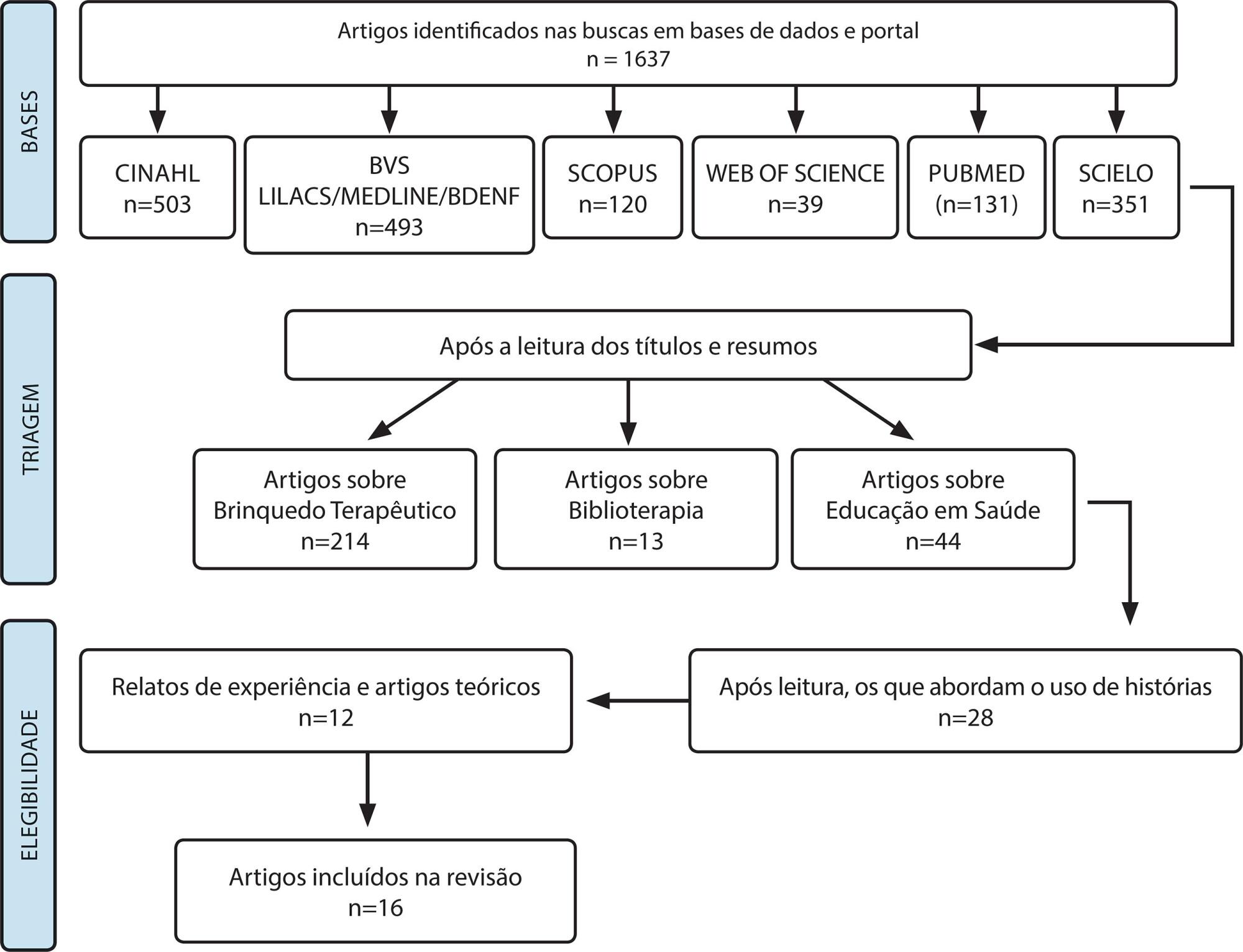
-
INFORME DE EXPERIENCIA
Use of webQDA software on qualitative nursing research: an experience report
Revista Brasileira de Enfermagem. 2020;73(3):e20180411
03/04/2020
Resumo
INFORME DE EXPERIENCIAUse of webQDA software on qualitative nursing research: an experience report
Revista Brasileira de Enfermagem. 2020;73(3):e20180411
03/04/2020DOI 10.1590/0034-7167-2018-0411
Visualizações0Ver maisABSTRACT
Objectives:
to report the user experience of the webQDA software in the support of qualitative data analysis about health literacy of older adults.
Methods:
quasi-experimental research developed from January 2014 to January 2015, with 118 older adults, all of whom were interviewed to assess the level of health literacy. Interviews were carried out before and after four educational interventions, according to Freire’s method named Culture Circle. The interviews were transcribed and entered in the software, which highlighted the analytical categories.
Results:
the systems of sources, interpretative encoding and questioning of the data available in the software allowed the construction of three categories for the literacy levels and four categories for their dimensions.
Final considerations:
We concluded that the webQDA software enables the structured encoding of qualitative materials, ensuring faster and effective management of data with systematization and analytical transparency.
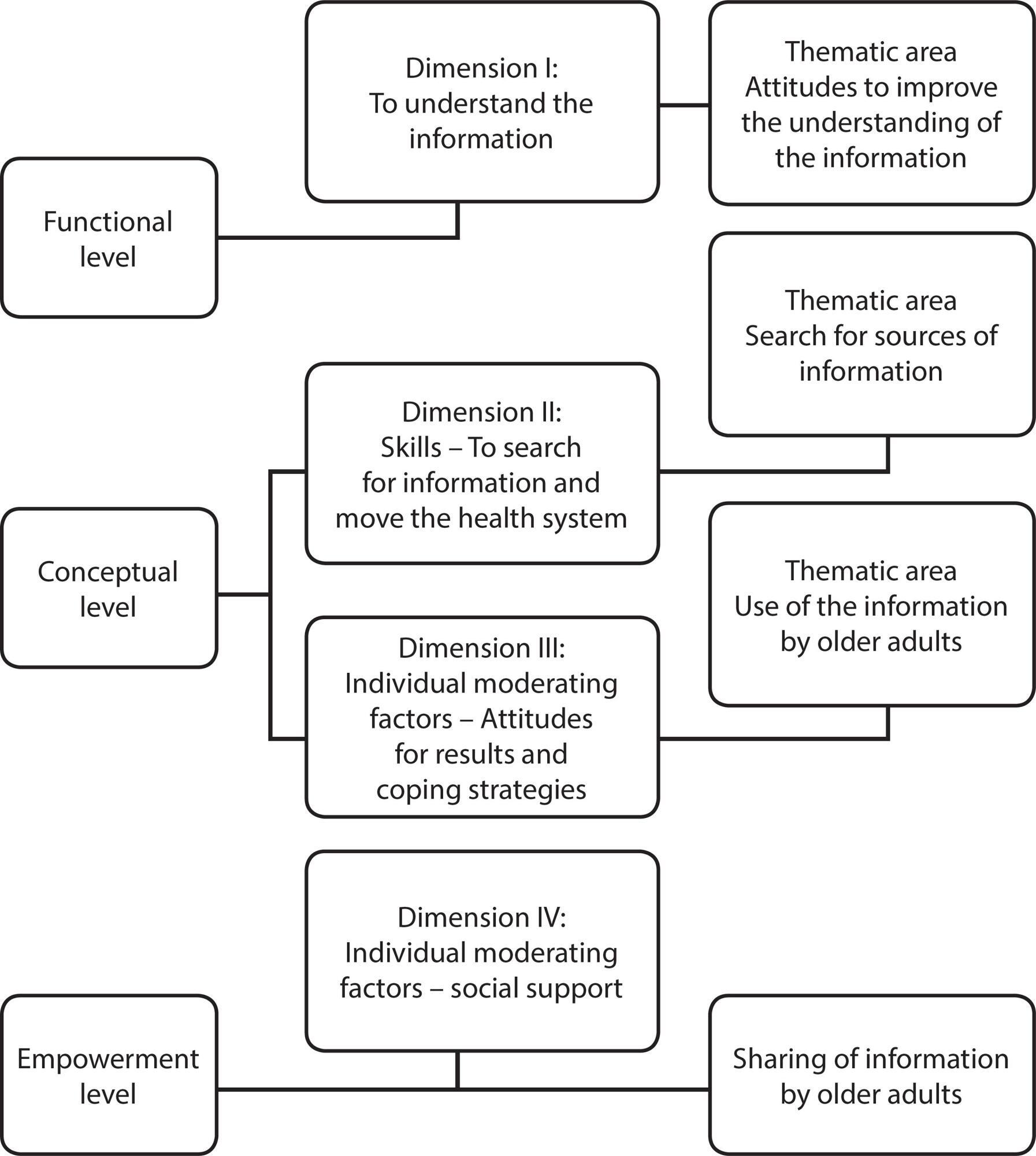
-
ARTÍCULO ORIGINAL
O cuidado da enfermeira à dimensão espiritual da pessoa idosa hospitalizada
Revista Brasileira de Enfermagem. 2019;72:236-242
05/12/2019
Resumo
ARTÍCULO ORIGINALO cuidado da enfermeira à dimensão espiritual da pessoa idosa hospitalizada
Revista Brasileira de Enfermagem. 2019;72:236-242
05/12/2019DOI 10.1590/0034-7167-2018-0685
Visualizações0Ver maisRESUMO
Objetivo:
analisar o cuidado da enfermeira à dimensão espiritual da pessoa idosa hospitalizada.
Método:
estudo qualitativo, fundamentado na Teoria do Cuidado Humano Transpessoal de Jean Watson. Fizeram parte do estudo 17 enfermeiras que trabalham em um centro geriátrico de Salvador, Bahia, Brasil. A coleta de depoimentos ocorreu entre janeiro e abril de 2018, através de entrevista.
Resultados:
os cuidados espirituais desvelados foram: diálogo, estímulos e respeito às atividades religiosas, acolhimento, empatia. Um dos obstáculos à prestação desses cuidados foi o despreparo em acessar a dimensão espiritual da pessoa idosa.
Considerações finais:
a espiritualidade é uma dimensão do cuidado humano e holístico de enfermagem. Cuidar do espírito contribui para fomentar o cuidado transpessoal. A dificuldade pode estar na falta de preparo de enfermeiras e enfermeiros, sendo necessário que cultivem e vivam sua própria espiritualidade, transmitindo a compreensão em cada relação de cuidado.
-
ARTÍCULO ORIGINAL
Creation and validation of a visual educational technology content for lactation physiology learning
Revista Brasileira de Enfermagem. 2020;73(6):e20190564
07/09/2020
Resumo
ARTÍCULO ORIGINALCreation and validation of a visual educational technology content for lactation physiology learning
Revista Brasileira de Enfermagem. 2020;73(6):e20190564
07/09/2020DOI 10.1590/0034-7167-2019-0564
Visualizações0ABSTRACT
Objective:
to create and validate a visual educational technology content for lactation physiology learning.
Method:
a methodological study that contemplated the stages of content creation and validation guided by the conceptual model of Knowledge Translation into action. The creation took place in partnership with the educational technology center of the project’s home institution. The validation was attended by 27 judges with experience in the obstetric, neonatal, pediatric or maternal and child areas and in the theme of breastfeeding.
Results:
an educational technology covered animation and video techniques to locate, respectively, elements of lactation physiology and the population involved. An Overall Content Validity Index of 0.84 was obtained.
Conclusion:
the visual educational technology for lactation physiology learning has been validated in content as a tool to introduce the theme and mediate health education actions that can have a positive impact on breastfeeding.
Palavras-chave: Audiovisual ResourcesEducational TechnologyHealth EducationLactationTranslational Medical ResearchVer mais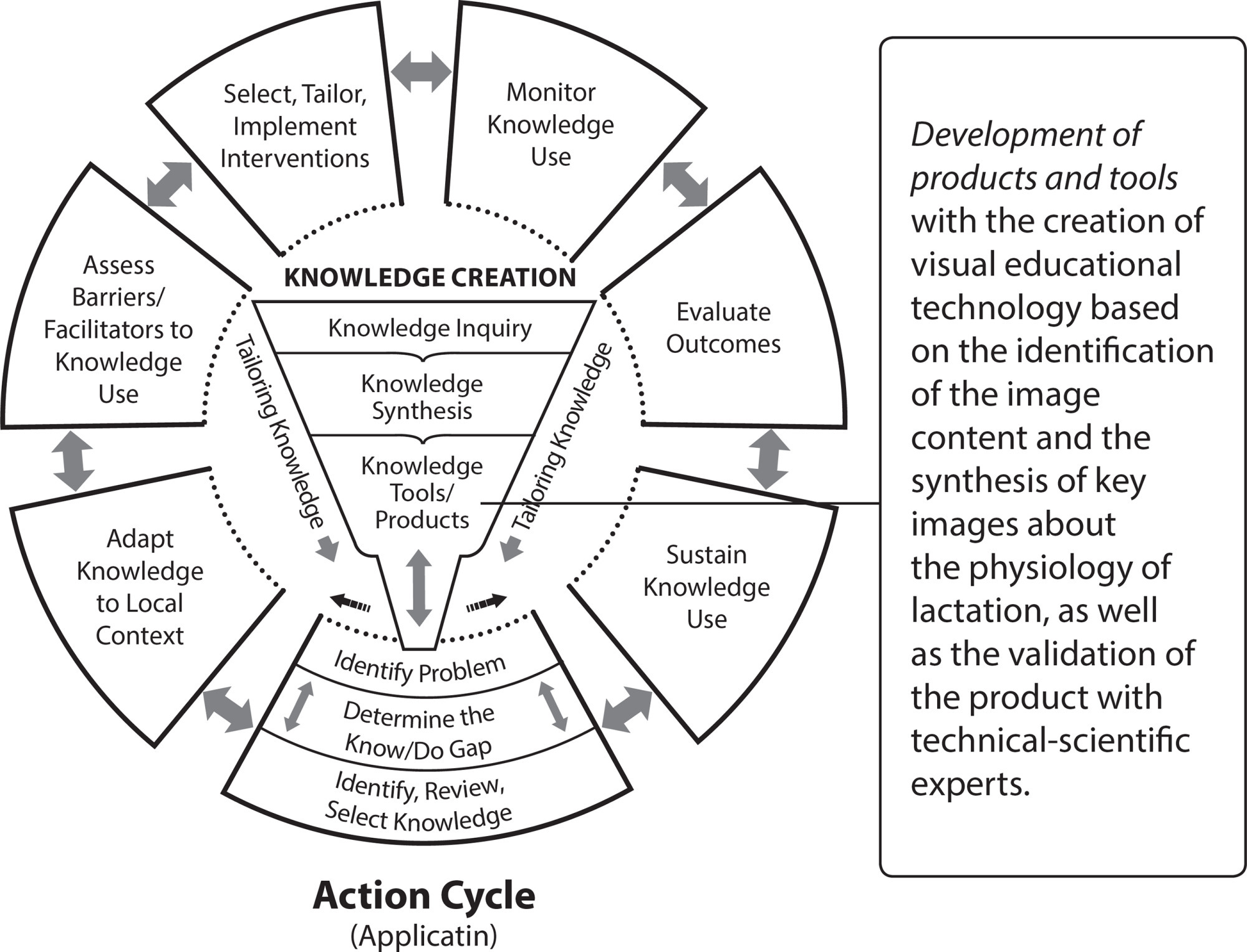
-
ARTÍCULO DE REVISIÓN
Historicidade da pós-graduação em enfermagem no Brasil: uma análise da sociologia das profissões
Revista Brasileira de Enfermagem. 2021;74(6):e20190827
20/08/2021
Resumo
ARTÍCULO DE REVISIÓNHistoricidade da pós-graduação em enfermagem no Brasil: uma análise da sociologia das profissões
Revista Brasileira de Enfermagem. 2021;74(6):e20190827
20/08/2021DOI 10.1590/0034-7167-2019-0827
Visualizações0RESUMO
Objetivos:
analisar as produções científicas acerca da história da pós-graduação em enfermagem brasileira à luz da Sociologia das Profissões de Eliot Freidson.
Métodos:
revisão integrativa, realizada nas bases indexadas na Biblioteca Virtual da Saúde. Seguiram-se as recomendações da Preferred Reporting Items for Systematic Reviews and Meta-Analyses. Adotaram-se a Análise de Conteúdo Temática e as concepções de Eliot Freidson.
Resultados:
elencaram-se duas categorias: “Institucionalização da pós-graduação em enfermagem brasileira”, ressaltando o processo histórico da profissionalização da enfermagem pela transição de um cuidado empírico para o profissional, subsidiado pelo monopólio da construção de saber próprio; “A produção científica da pós-graduação em enfermagem no Brasil”, evidenciando o fortalecimento da nova geração de enfermeiros pesquisadores no país, visto a maior cientificidade no ensino pela implantação da pós-graduação.
Considerações Finais:
as análises apresentam a historicidade da institucionalização da pós-graduação subsidiando a compreensão dos delineamentos da profissionalização da enfermagem brasileira.
Palavras-chave: BrasilEducação de Pós-Graduação em EnfermagemEnfermagemHistória da EnfermagemRevisãoVer mais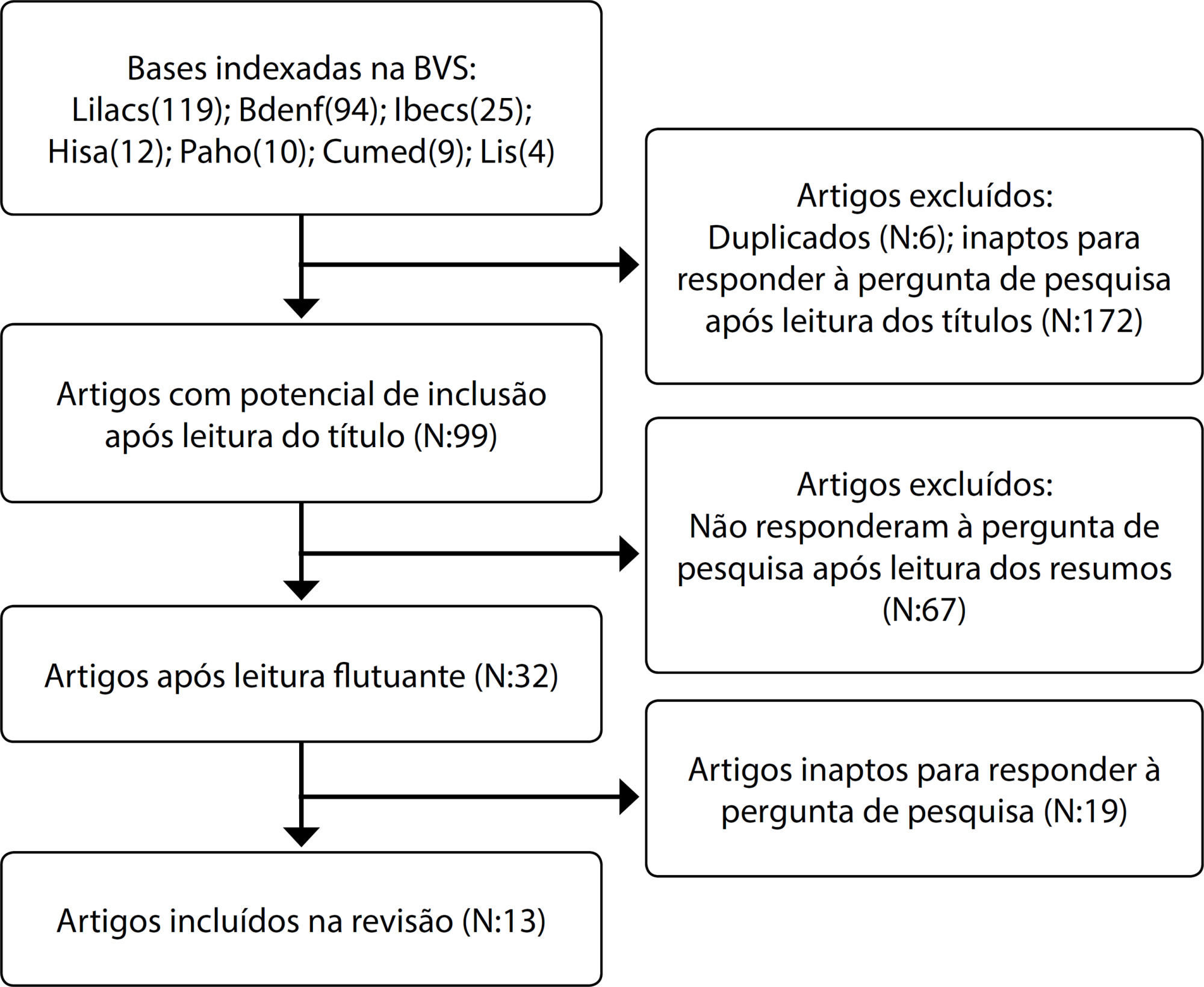
-
ARTÍCULO ORIGINAL
Risk of suicide among nursing students
Revista Brasileira de Enfermagem. 2021;74(6):e20200867
20/08/2021
Resumo
ARTÍCULO ORIGINALRisk of suicide among nursing students
Revista Brasileira de Enfermagem. 2021;74(6):e20200867
20/08/2021DOI 10.1590/0034-7167-2020-0867
Visualizações0Ver maisABSTRACT
Objectives:
to identify the risk and degree of risk of suicide in nursing students of a public institution in the countryside of Pernambuco, Brazil.
Methods:
this was a cross-sectional, quantitative research conducted with 150 students. For data collection, a sociodemographic questionnaire and the instrument, M.I.N.I. – Brazilian version 5.0.0 – Module C – Risk of suicide were used. Statistical analyses were performed with IBM(® )SPSS(®), version 23.
Results:
53.3% of nursing students had a risk of suicide, of which 20.7% had a high risk. Moreover, 22.67% reported previous suicide attempt. It is noteworthy that students without a partner have a higher risk of suicide (56.8%) than those with a partner (29.4%).
Conclusions:
it is perceived the need to develop programs that identify students at risk of suicide in higher education institutions, in order to raise awareness of the problem and implement policies to promote mental health in the academia.
Búsqueda
Buscar en:
Nuvem de Tags
Adolescente (85) Atenção Primária à Saúde (239) COVID-19 (91) Criança (91) Cuidados de Enfermagem (269) Educação em Enfermagem (151) Educação em Saúde (139) Enfermagem (930) Enfermagem Pediátrica (86) Estudantes de Enfermagem (77) Estudos de Validação (131) Família (87) Idoso (208) Promoção da Saúde (99) Qualidade de Vida (104) Saúde do Trabalhador (86) Saúde Mental (145) Saúde Pública (82) Segurança do Paciente (150) Tecnologia Educacional (100)



